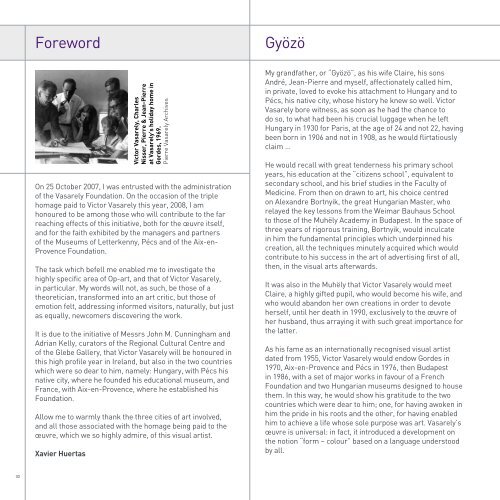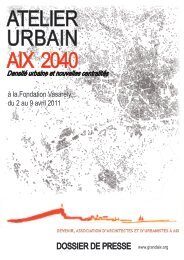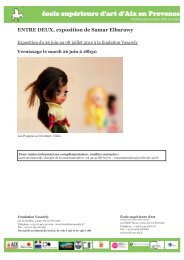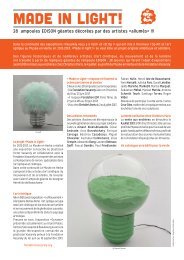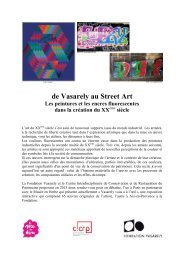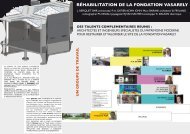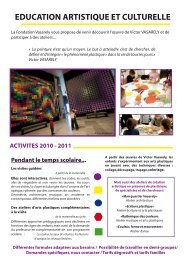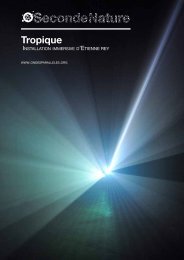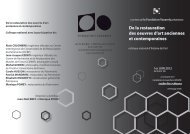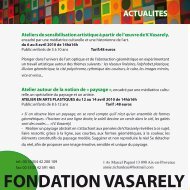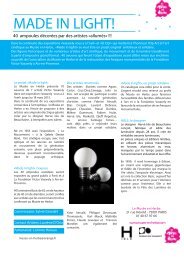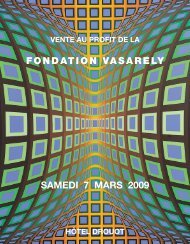Victor Vasarely - Fondation Vasarely
Victor Vasarely - Fondation Vasarely
Victor Vasarely - Fondation Vasarely
Create successful ePaper yourself
Turn your PDF publications into a flip-book with our unique Google optimized e-Paper software.
8<br />
Foreword Gyözö<br />
On 25 October 2007, I was entrusted with the administration<br />
of the <strong>Vasarely</strong> Foundation. On the occasion of the triple<br />
homage paid to <strong>Victor</strong> <strong>Vasarely</strong> this year, 2008, I am<br />
honoured to be among those who will contribute to the far<br />
reaching effects of this initiative, both for the œuvre itself,<br />
and for the faith exhibited by the managers and partners<br />
of the Museums of Letterkenny, Pécs and of the Aix-en-<br />
Provence Foundation.<br />
The task which befell me enabled me to investigate the<br />
highly specific area of Op-art, and that of <strong>Victor</strong> <strong>Vasarely</strong>,<br />
in particular. My words will not, as such, be those of a<br />
theoretician, transformed into an art critic, but those of<br />
emotion felt, addressing informed visitors, naturally, but just<br />
as equally, newcomers discovering the work.<br />
It is due to the initiative of Messrs John M. Cunningham and<br />
Adrian Kelly, curators of the Regional Cultural Centre and<br />
of the Glebe Gallery, that <strong>Victor</strong> <strong>Vasarely</strong> will be honoured in<br />
this high profile year in Ireland, but also in the two countries<br />
which were so dear to him, namely: Hungary, with Pécs his<br />
native city, where he founded his educational museum, and<br />
France, with Aix-en-Provence, where he established his<br />
Foundation.<br />
Allow me to warmly thank the three cities of art involved,<br />
and all those associated with the homage being paid to the<br />
œuvre, which we so highly admire, of this visual artist.<br />
Xavier Huertas<br />
<strong>Victor</strong> <strong>Vasarely</strong>, Charles<br />
Nisser, Pierre & Jean-Pierre<br />
at <strong>Vasarely</strong>'s holiday home in<br />
Gordes, 1969.<br />
Pierre <strong>Vasarely</strong> Archives<br />
My grandfather, or “Gyözö”, as his wife Claire, his sons<br />
André, Jean-Pierre and myself, affectionately called him,<br />
in private, loved to evoke his attachment to Hungary and to<br />
Pécs, his native city, whose history he knew so well. <strong>Victor</strong><br />
<strong>Vasarely</strong> bore witness, as soon as he had the chance to<br />
do so, to what had been his crucial luggage when he left<br />
Hungary in 1930 for Paris, at the age of 24 and not 22, having<br />
been born in 1906 and not in 1908, as he would flirtatiously<br />
claim …<br />
He would recall with great tenderness his primary school<br />
years, his education at the “citizens school”, equivalent to<br />
secondary school, and his brief studies in the Faculty of<br />
Medicine. From then on drawn to art, his choice centred<br />
on Alexandre Bortnyik, the great Hungarian Master, who<br />
relayed the key lessons from the Weimar Bauhaus School<br />
to those of the Muhëly Academy in Budapest. In the space of<br />
three years of rigorous training, Bortnyik, would inculcate<br />
in him the fundamental principles which underpinned his<br />
creation, all the techniques minutely acquired which would<br />
contribute to his success in the art of advertising first of all,<br />
then, in the visual arts afterwards.<br />
It was also in the Muhëly that <strong>Victor</strong> <strong>Vasarely</strong> would meet<br />
Claire, a highly gifted pupil, who would become his wife, and<br />
who would abandon her own creations in order to devote<br />
herself, until her death in 1990, exclusively to the œuvre of<br />
her husband, thus arraying it with such great importance for<br />
the latter.<br />
As his fame as an internationally recognised visual artist<br />
dated from 1955, <strong>Victor</strong> <strong>Vasarely</strong> would endow Gordes in<br />
1970, Aix-en-Provence and Pécs in 1976, then Budapest<br />
in 1986, with a set of major works in favour of a French<br />
Foundation and two Hungarian museums designed to house<br />
them. In this way, he would show his gratitude to the two<br />
countries which were dear to him; one, for having awoken in<br />
him the pride in his roots and the other, for having enabled<br />
him to achieve a life whose sole purpose was art. <strong>Vasarely</strong>’s<br />
œuvre is universal: in fact, it introduced a development on<br />
the notion “form – colour” based on a language understood<br />
by all.


